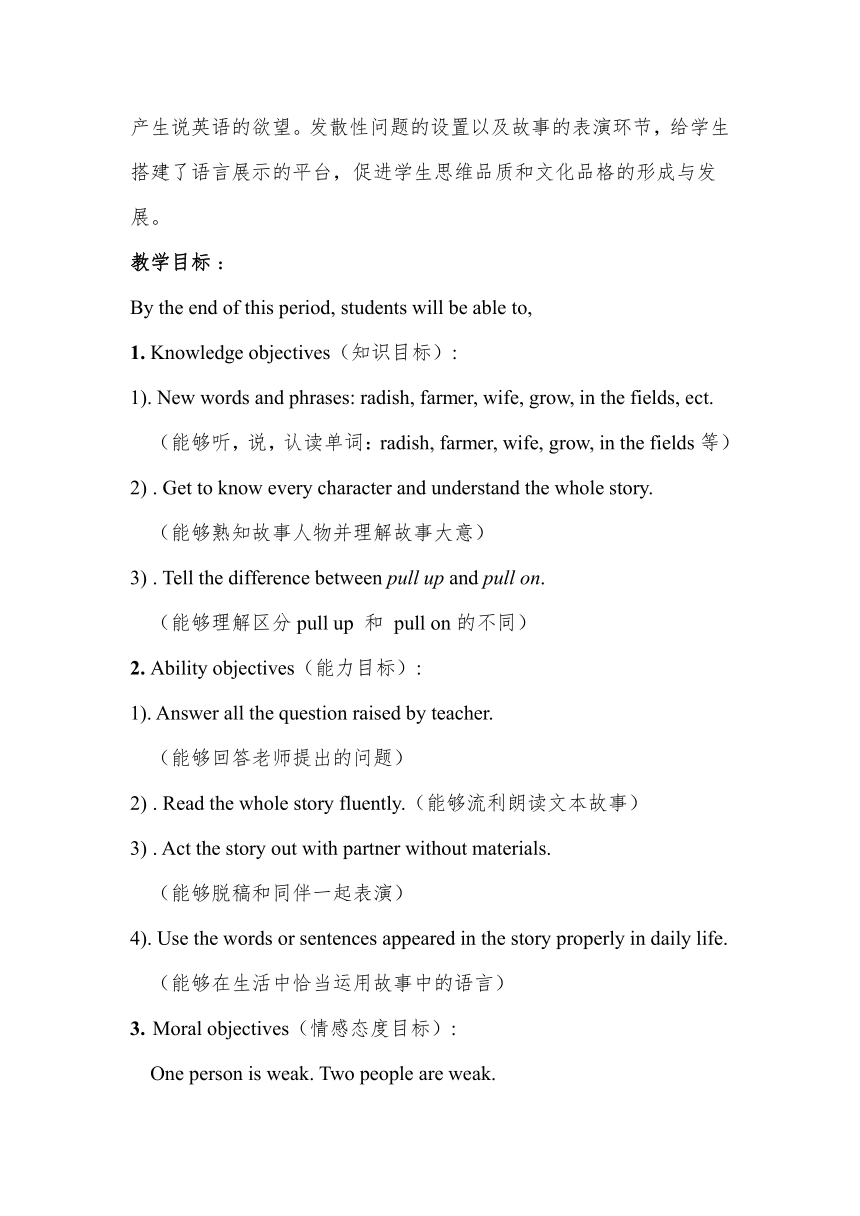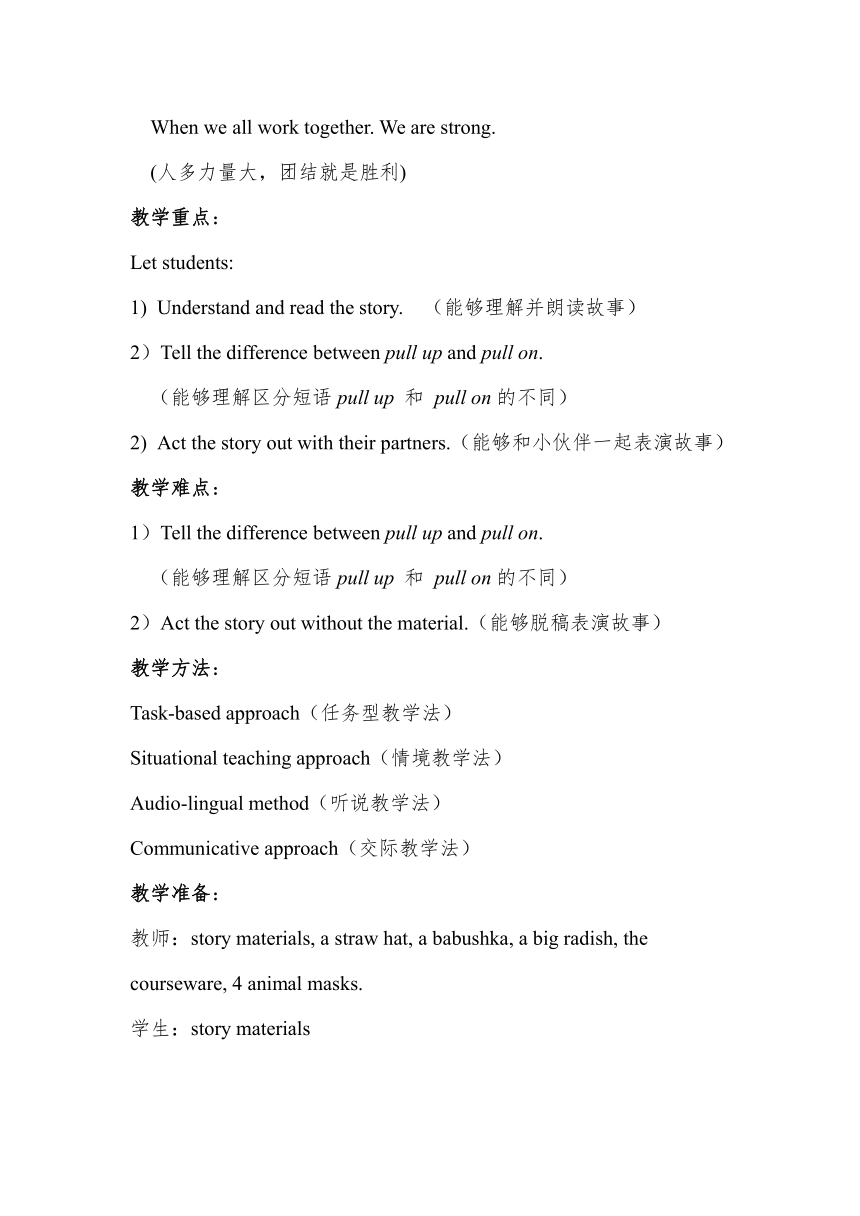小学英语清华大学版三年级上册 Fun reading the farmer and the radish 教案
文档属性
| 名称 | 小学英语清华大学版三年级上册 Fun reading the farmer and the radish 教案 |  | |
| 格式 | doc | ||
| 文件大小 | 7.0MB | ||
| 资源类型 | 教案 | ||
| 版本资源 | 清华大学版 | ||
| 科目 | 英语 | ||
| 更新时间 | 2022-11-19 11:19:10 | ||
图片预览




文档简介
三年级英语上册
(清华大学出版社)
Fun Reading - The Farmer and the Radish
课题:Fun Reading - The Farmer and the Radish
课型:故事课
教材分析:
故事The Farmer and the Radish选自清华版教材最后一个板块-Fun Reading。该板块旨在让学生充分享受英语阅读所带来的快乐,从而提高学生学习英语的兴趣与积极性。更重要的是为能力较强的学生提供语言展示的平台,以达到分层次教学的目的。充满童趣的“拔萝卜”故事体现了互相帮助,团结合作的主题。学生除了复习之前学过的一些词汇句型外,还可以通过图片和上下文理解新句子:They grow radishes in the fields. The wife pulls on the farmer.等
学情分析:
通过三年课内外的英语学习,同学们有一定知识的储备,能听懂老师的英语指令,能进行简单的英语交流。重要的是表演欲望很强,这就为学习英语创造了积极的语言环境。
设计思路:
本课教学设计尽可能地体现义务教育《英语课程标准》的教学理念,面向全体学生,突出学生主体,采用活动途径,恰当地运用电教手段创设情境,通过听故事、看故事、读故事、讲故事和演故事五个环节,激发和培养学生学习英语的兴趣,使学生树立自信心,让学生产生说英语的欲望。发散性问题的设置以及故事的表演环节,给学生搭建了语言展示的平台,促进学生思维品质和文化品格的形成与发展。
教学目标 :
By the end of this period, students will be able to,
1. Knowledge objectives(知识目标):
1). New words and phrases: radish, farmer, wife, grow, in the fields, ect.
(能够听,说,认读单词:radish, farmer, wife, grow, in the fields等)
2) . Get to know every character and understand the whole story.
(能够熟知故事人物并理解故事大意)
3) . Tell the difference between pull up and pull on.
(能够理解区分pull up 和 pull on的不同)
2. Ability objectives(能力目标):
1). Answer all the question raised by teacher.
(能够回答老师提出的问题)
2) . Read the whole story fluently.(能够流利朗读文本故事)
3) . Act the story out with partner without materials.
(能够脱稿和同伴一起表演)
4). Use the words or sentences appeared in the story properly in daily life.(能够在生活中恰当运用故事中的语言)
3. Moral objectives(情感态度目标):
One person is weak. Two people are weak.
When we all work together. We are strong.
(人多力量大,团结就是胜利)
教学重点:
Let students:
1) Understand and read the story. (能够理解并朗读故事)
2)Tell the difference between pull up and pull on.
(能够理解区分短语pull up 和 pull on的不同)
2) Act the story out with their partners.(能够和小伙伴一起表演故事)
教学难点:
1)Tell the difference between pull up and pull on.
(能够理解区分短语pull up 和 pull on的不同)
2)Act the story out without the material.(能够脱稿表演故事)
教学方法:
Task-based approach(任务型教学法)
Situational teaching approach(情境教学法)
Audio-lingual method(听说教学法)
Communicative approach(交际教学法)
教学准备:
教师:story materials, a straw hat, a babushka, a big radish, the courseware, 4 animal masks.
学生:story materials
教学过程:
Step 1: Greeting and warm-up.
1) Greet to the whole class.
2) Sing Vegetable Song and do the actions.
(师生问好、歌曲Vegetable Song热身)
【设计意图:歌曲Vegetable Song 缓解学生紧张情绪并课前热身,同时为接下来的提问环节做铺垫】
Step 2: Presentation.
1)Q:Which vegetable do you like
S1: I like...
S2: I like...
T leads Ss to ask her the question that can present the new word radish.
At the same time, tell the difference between radish and carrot.
(师生问答引出新单词radish,同时和carrot进行区分)
【设计意图:问题的设置和热身歌曲无缝对接,单词radish自然带出】
2)T: Look, there are so many radishes in the fields.
(教师提前把黑板下方布置成田地,并把大小不等的radish插进泥土里,明确奖励机制)
New words teaching: radishes, in the fields
T:(T points at the picture)Who is he / Who is she
New words teaching: farmer, wife
黑板布置如下:
T:Today we will learn a story named The Farmer and the Radish
【设计意图:黑板的用心布置为孩子们接下来的故事学习创设了情境,奖励机制暗藏其中】
3)Ss watch and answer the question:
Who will help the farmer and his wife → cow, dog, cat, rat
(欣赏故事并简单提问)
【设计意图:图片与音频的结合让学生了解故事内容,大量重复的语句给孩子们“磨耳朵”】
4)T shows Ss the picture and asks Ss guess and answer:
① Where do they live
② What do they do on the farm
③ Why do they want to pull up the radish
(要求同学们观察图片再结合文本回答问题)
【设计意图:问题的设置具有梯度性,发散思维的同时锻炼孩子们的语言表达能力】
5)(The farmer and his wife are pulling up the radish.)
T: Can they pull up the radish
→(No, they can’t.)The radish does not come up.
(根据图片让学生回答问题的同时自然带出新句型。)
6) T: Here comes a cow and he will help them.
According to the picture, T leads Ss to describe it.
T: The cow pulls on the wife.
S1: The wife pulls on the farmer.
S2: The farmer pulls on the radish.
T explains the phrase pull on and wants to pull up a big radish for one student, pretending can’t pull it up.
(要求同学们根据例句描述拔萝卜的场景,并解释短语pull on)
【设计意图:假装“奖励的萝卜”拔不出需要大家的帮助,同学们可以把刚刚在文中学到的句型灵活运用】
7) T: Can they pull up the radish
→(No, they can’t.)The radish still does not come up.
(根据图片回答问题)
Teach the new word: still
8) T: Dog and cat will help.
Ss read P69~P70 by themselves and then
describe the picture without materials.
(学生自读课文并回答问题,巩固sb.pull on sb.句型)
【设计意图:反复的诵读和描述以达到知识内化的目的】
9)T: But they failed again.
→(Lead Ss to say)The radish still does not come up.
T: Don’t be sad. Maybe they need more help. Look, here comes a little rat and he wants to help.
Describe the picture and presents the new sentences pattern.
(描述给定的图片并新授句型)
10)T:What are they doing
→ They are eating the radish(for dinner).
(现在进行时句子的提问给个别同学语言展示的机会。)
【设计意图:在描述图片的同时加深对文本的熟悉程度,为接下来的朗读甚至是表演做铺垫】
Step 3: Practice and expansion
1) Ss read after the MP3 and answer the question:
How many times (多少次) do they pull up the radish →5 times.
(跟读课文,回答问题)
2)Choose your favourite character and role-play to read.
(选择自己喜欢的人物,角色扮演朗读课文)
【设计意图:不同形式的朗读再次加深对文本的熟悉程度,为接下来的表演做铺垫】
3)Work in group of seven to practice. (小组内练习表演)
4)Group show time. (小组展示)
【设计意图:为能力较强的学生提供语言展示的平台,以达到分层次教学的目的。】
5)Moral education:
T: School just like a big family. As usual we should learn from each other and help each other. Look, these are some of your daily life photos.
Please remember, wherever you are: One person is weak. Two people are weak. When we all work together. We are strong.
(情感教育:人多力量大,团结就是胜利。)
【设计意图:搜集,整理并呈现孩子们日常生活中互相帮助的温暖照片,引起同学们共鸣。】
板书设计:
The radish comes out.
The radish comes out.
T
times!
(清华大学出版社)
Fun Reading - The Farmer and the Radish
课题:Fun Reading - The Farmer and the Radish
课型:故事课
教材分析:
故事The Farmer and the Radish选自清华版教材最后一个板块-Fun Reading。该板块旨在让学生充分享受英语阅读所带来的快乐,从而提高学生学习英语的兴趣与积极性。更重要的是为能力较强的学生提供语言展示的平台,以达到分层次教学的目的。充满童趣的“拔萝卜”故事体现了互相帮助,团结合作的主题。学生除了复习之前学过的一些词汇句型外,还可以通过图片和上下文理解新句子:They grow radishes in the fields. The wife pulls on the farmer.等
学情分析:
通过三年课内外的英语学习,同学们有一定知识的储备,能听懂老师的英语指令,能进行简单的英语交流。重要的是表演欲望很强,这就为学习英语创造了积极的语言环境。
设计思路:
本课教学设计尽可能地体现义务教育《英语课程标准》的教学理念,面向全体学生,突出学生主体,采用活动途径,恰当地运用电教手段创设情境,通过听故事、看故事、读故事、讲故事和演故事五个环节,激发和培养学生学习英语的兴趣,使学生树立自信心,让学生产生说英语的欲望。发散性问题的设置以及故事的表演环节,给学生搭建了语言展示的平台,促进学生思维品质和文化品格的形成与发展。
教学目标 :
By the end of this period, students will be able to,
1. Knowledge objectives(知识目标):
1). New words and phrases: radish, farmer, wife, grow, in the fields, ect.
(能够听,说,认读单词:radish, farmer, wife, grow, in the fields等)
2) . Get to know every character and understand the whole story.
(能够熟知故事人物并理解故事大意)
3) . Tell the difference between pull up and pull on.
(能够理解区分pull up 和 pull on的不同)
2. Ability objectives(能力目标):
1). Answer all the question raised by teacher.
(能够回答老师提出的问题)
2) . Read the whole story fluently.(能够流利朗读文本故事)
3) . Act the story out with partner without materials.
(能够脱稿和同伴一起表演)
4). Use the words or sentences appeared in the story properly in daily life.(能够在生活中恰当运用故事中的语言)
3. Moral objectives(情感态度目标):
One person is weak. Two people are weak.
When we all work together. We are strong.
(人多力量大,团结就是胜利)
教学重点:
Let students:
1) Understand and read the story. (能够理解并朗读故事)
2)Tell the difference between pull up and pull on.
(能够理解区分短语pull up 和 pull on的不同)
2) Act the story out with their partners.(能够和小伙伴一起表演故事)
教学难点:
1)Tell the difference between pull up and pull on.
(能够理解区分短语pull up 和 pull on的不同)
2)Act the story out without the material.(能够脱稿表演故事)
教学方法:
Task-based approach(任务型教学法)
Situational teaching approach(情境教学法)
Audio-lingual method(听说教学法)
Communicative approach(交际教学法)
教学准备:
教师:story materials, a straw hat, a babushka, a big radish, the courseware, 4 animal masks.
学生:story materials
教学过程:
Step 1: Greeting and warm-up.
1) Greet to the whole class.
2) Sing Vegetable Song and do the actions.
(师生问好、歌曲Vegetable Song热身)
【设计意图:歌曲Vegetable Song 缓解学生紧张情绪并课前热身,同时为接下来的提问环节做铺垫】
Step 2: Presentation.
1)Q:Which vegetable do you like
S1: I like...
S2: I like...
T leads Ss to ask her the question that can present the new word radish.
At the same time, tell the difference between radish and carrot.
(师生问答引出新单词radish,同时和carrot进行区分)
【设计意图:问题的设置和热身歌曲无缝对接,单词radish自然带出】
2)T: Look, there are so many radishes in the fields.
(教师提前把黑板下方布置成田地,并把大小不等的radish插进泥土里,明确奖励机制)
New words teaching: radishes, in the fields
T:(T points at the picture)Who is he / Who is she
New words teaching: farmer, wife
黑板布置如下:
T:Today we will learn a story named The Farmer and the Radish
【设计意图:黑板的用心布置为孩子们接下来的故事学习创设了情境,奖励机制暗藏其中】
3)Ss watch and answer the question:
Who will help the farmer and his wife → cow, dog, cat, rat
(欣赏故事并简单提问)
【设计意图:图片与音频的结合让学生了解故事内容,大量重复的语句给孩子们“磨耳朵”】
4)T shows Ss the picture and asks Ss guess and answer:
① Where do they live
② What do they do on the farm
③ Why do they want to pull up the radish
(要求同学们观察图片再结合文本回答问题)
【设计意图:问题的设置具有梯度性,发散思维的同时锻炼孩子们的语言表达能力】
5)(The farmer and his wife are pulling up the radish.)
T: Can they pull up the radish
→(No, they can’t.)The radish does not come up.
(根据图片让学生回答问题的同时自然带出新句型。)
6) T: Here comes a cow and he will help them.
According to the picture, T leads Ss to describe it.
T: The cow pulls on the wife.
S1: The wife pulls on the farmer.
S2: The farmer pulls on the radish.
T explains the phrase pull on and wants to pull up a big radish for one student, pretending can’t pull it up.
(要求同学们根据例句描述拔萝卜的场景,并解释短语pull on)
【设计意图:假装“奖励的萝卜”拔不出需要大家的帮助,同学们可以把刚刚在文中学到的句型灵活运用】
7) T: Can they pull up the radish
→(No, they can’t.)The radish still does not come up.
(根据图片回答问题)
Teach the new word: still
8) T: Dog and cat will help.
Ss read P69~P70 by themselves and then
describe the picture without materials.
(学生自读课文并回答问题,巩固sb.pull on sb.句型)
【设计意图:反复的诵读和描述以达到知识内化的目的】
9)T: But they failed again.
→(Lead Ss to say)The radish still does not come up.
T: Don’t be sad. Maybe they need more help. Look, here comes a little rat and he wants to help.
Describe the picture and presents the new sentences pattern.
(描述给定的图片并新授句型)
10)T:What are they doing
→ They are eating the radish(for dinner).
(现在进行时句子的提问给个别同学语言展示的机会。)
【设计意图:在描述图片的同时加深对文本的熟悉程度,为接下来的朗读甚至是表演做铺垫】
Step 3: Practice and expansion
1) Ss read after the MP3 and answer the question:
How many times (多少次) do they pull up the radish →5 times.
(跟读课文,回答问题)
2)Choose your favourite character and role-play to read.
(选择自己喜欢的人物,角色扮演朗读课文)
【设计意图:不同形式的朗读再次加深对文本的熟悉程度,为接下来的表演做铺垫】
3)Work in group of seven to practice. (小组内练习表演)
4)Group show time. (小组展示)
【设计意图:为能力较强的学生提供语言展示的平台,以达到分层次教学的目的。】
5)Moral education:
T: School just like a big family. As usual we should learn from each other and help each other. Look, these are some of your daily life photos.
Please remember, wherever you are: One person is weak. Two people are weak. When we all work together. We are strong.
(情感教育:人多力量大,团结就是胜利。)
【设计意图:搜集,整理并呈现孩子们日常生活中互相帮助的温暖照片,引起同学们共鸣。】
板书设计:
The radish comes out.
The radish comes out.
T
times!
